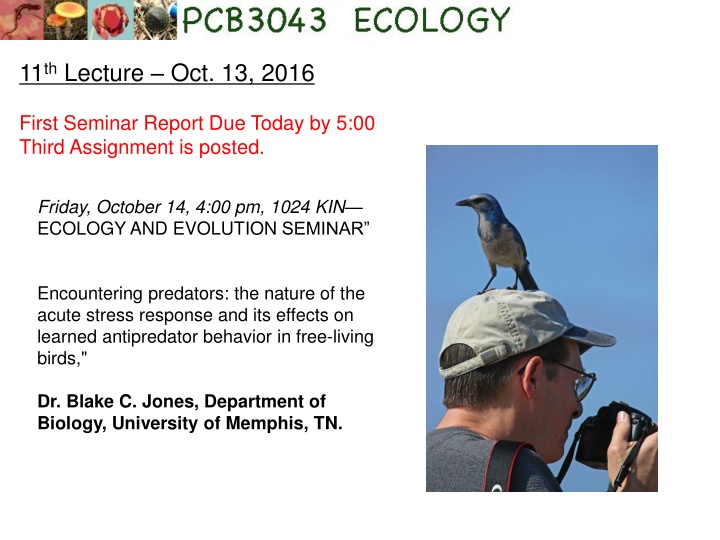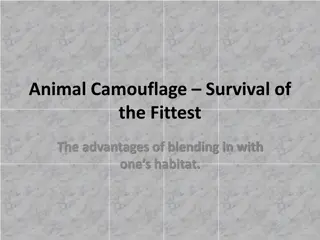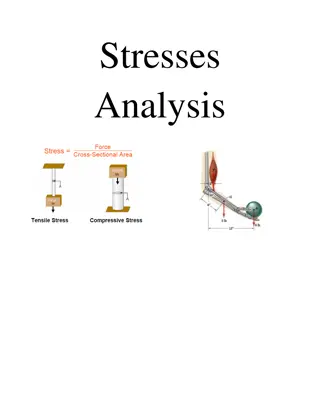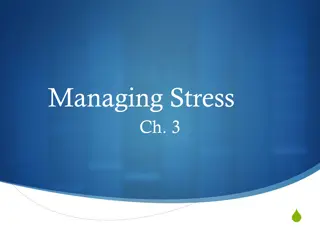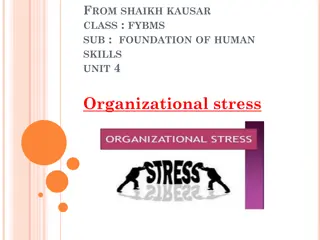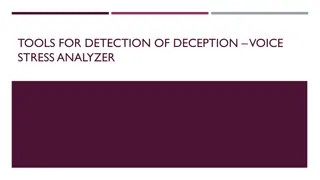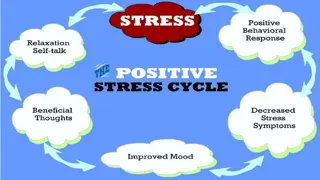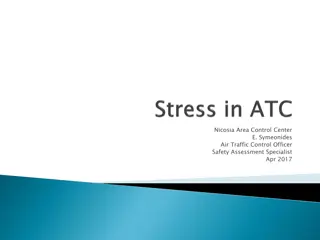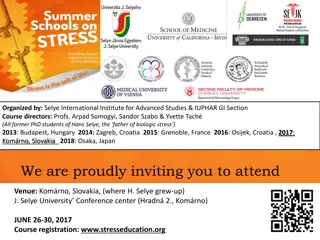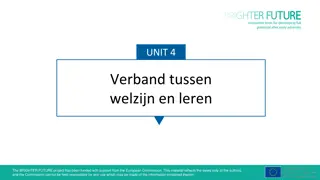Encountering Predators: Stress Response & Effects on Antipredator Behavior
Delve into competition in biology with a seminar report on stress response and antipredator behavior in birds, Ligia distribution, phase plane analysis, and population dynamics models of competition. Explore Lotka-Volterra equations, isoclines, and more.
Download Presentation

Please find below an Image/Link to download the presentation.
The content on the website is provided AS IS for your information and personal use only. It may not be sold, licensed, or shared on other websites without obtaining consent from the author.If you encounter any issues during the download, it is possible that the publisher has removed the file from their server.
You are allowed to download the files provided on this website for personal or commercial use, subject to the condition that they are used lawfully. All files are the property of their respective owners.
The content on the website is provided AS IS for your information and personal use only. It may not be sold, licensed, or shared on other websites without obtaining consent from the author.
E N D
Presentation Transcript
11th Lecture Oct. 13, 2016 First Seminar Report Due Today by 5:00 Third Assignment is posted. Friday, October 14, 4:00 pm, 1024 KIN ECOLOGY AND EVOLUTION SEMINAR Encountering predators: the nature of the acute stress response and its effects on learned antipredator behavior in free-living birds," Dr. Blake C. Jones, Department of Biology, University of Memphis, TN.
Ligia Distribution 600 Numbers of Ligia per Plot 500 400 300 200 100 0 0 20 40 60 80 100 120 140 160 UPPER LIMIT (INTERTIDAL) LOWER LIMIT (SUBTIDAL) Depth
We are going to delve into competition stuff for awhile. Remember: BIOLOGY MATH GRAPHS
PHASE PLANE Isocline where dN/dt = 0 for red fish - - - dN/dt < 0 - - - - Number of Blue fish (NB) - - - + - + - - + + - + dN/dt > 0 + + + + + - + Number of Red fish (NR)
PHASE PLANE - - - dN/dt < 0 - - - - Number of Blue fish (NB) - - - + - - - + + - + dN/dt > 0 + + + + + + + Number of Red fish (NR)
PHASE PLANE Remember that the growth rate of each species on its isocline is ZERO. Number of Blue fish (NB) Number of Red fish (NR)
Species 1 wins Species 2 wins
Unstable equilibrium Stable equilibrium
We are going to delve into competition stuff for awhile. Remember: BIOLOGY MATH GRAPHS
V. Populations and Biotic Influences . . . . . . . 3. Simple Models of Competition -- a. Lotka-Volterra equations and isoclines i) extend logistic equation to two species dN dt dN dt dN1 dt =rN exponential =rN(K -N intraspecific competition ) K =r1N1(K1-N1-a12N2 Interspecific (and intraspecific) competition ) K1
V. Populations and Biotic Influences . . . . . . . 3. Simple Models of Competition -- a. Lotka-Volterra equations and isoclines i) extend logistic equation to two species dN1 dt = r1N1(K1-N1-a12N2 ) K1 = r2N2(K2-N2-a21N1 dN2 dt ) K2 But, these just tell us the growth rates of the two species, not who wins in competition or if they coexist. The outcome of competition involves looking at when dN/dt = 0.
V. Populations and Biotic Influences . . . . . . . 3. Simple Models of Competition -- a. Lotka-Volterra equations and isoclines i) extend logistic equation to two species ii) set equations to zero and derive isoclines In both the previous two scenarios seen in the graphs, the growth rates of the two species go to zero. So we can set our growth equations to zero to figure out what happens at equilibrium, when the growth rate of the species is zero. = r1N1(K1-N1-a12N2 dN1 dt )=0 K1
V. Populations and Biotic Influences . . . . . . . 3. Simple Models of Competition -- a. Lotka-Volterra equations and isoclines i) extend logistic equation to two species ii) set equations to zero and derive isoclines dN1 dt 0=K1-N1-a12N2 =0= r1N1(K1-N1-a12N2 ) K1 N1=K1-a12N2 N2=K2-a21N1
V. Populations and Biotic Influences . . . . . . . 3. Simple Models of Competition -- a. Lotka-Volterra equations and isoclines i) extend logistic equation to two species ii) set equations to zero and derive isoclines dN1 dt 0=K1-N1-a12N2 What does this mean? This is true when the growth rate of the species is zero. =0= r1N1(K1-N1-a12N2 ) K1 It also describes a line on our graph of N1 against N2. N1=K1-a12N2 N2=K2-a21N1
CRITERION FOR COEXISTENCE N1= K1-a12N2 K1=a12N2 N2= K1/a12 K1/ 12 NUMBER OF BLUE FISH K2 Better competitor will have the outside isocline, which requires a higher K or a lower alpha. K2/ 21 K1 NUMBER OF RED FISH
b. Lotka-Volterra models. Make equations (b-d) Phase- space isoclines Interaction Equilibrium (dN/dt = 0) Make predictions K1-N1-a12N2 K1 dN1 dt = r1N1 Who wins? Coexistence? N1=K1-a12N2 competition K2-N2-a21N1 K2 N2=K2-a21N1 dN2 dt = r2N2 predation
V. Populations and Biotic Influences . . . . . . . . 3. Simple Models of Competition -- a. Lotka-Volterra equations and isoclines b. Predictions: The model allows us to make predictions about what factors determine competitive outcomes. i. Competition can lead to one of four outcomes (1 always wins, 2 always wins, 1&2 coexist or either 1 or 2 can win depending on initial abundances). ii. Competitive outcome is dependent on K and . Species with higher K and/or lower 12 will be better competitors.
V. Populations and Biotic Influences . . . . . . . . 3. Simple Models of Competition -- a. Lotka-Volterra equations and isoclines b. Predictions: The model allows us to make predictions about what factors determine competitive outcomes. i. Competition can lead to one of four outcomes ii. Competitive outcome is dependent on K and iii. Competitive outcome is not dependent on r N1=K1-a12N2 N2=K2-a21N1
Species 1 wins Species 2 wins
Unstable equilibrium Stable equilibrium
V. Populations and Biotic Influences . . . . . . . . 3. Simple Models of Competition -- a. Lotka-Volterra equations and isoclines b. Predictions: The model allows us to make predictions about what factors determine competitive outcomes. i. Competition can lead to one of four outcomes ii. Competitive outcome is dependent on K and iii. Competitive outcome is not dependent on r iv. Coexistence requires that intraspecific competition (=1) is greater than interspecific competition (alpha s) for both species.
CRITERION FOR COEXISTENCE K1/ 12 NUMBER OF BLUE FISH Stable coexistence of competitors requires that K/ > K K2 so that, IF the K s are relatively similar in size: < 1.0 K2/ 21 K1 NUMBER OF RED FISH
CRITERION FOR COEXISTENCE Coexistence of competitors requires that: K/ > K so that < 1.0 K1/ 12 NUMBER OF BLUE FISH K2 Another way of stating this is that, for similar species (K s are similar), coexistence requires that intraspecific competition ( 11 and 22 = 1) be greater than interspecific competition ( 12 and 21 < 1.0) K2/ 21 K1 NUMBER OF RED FISH
In Class Worksheet: 80 80 alone N2 60 60 N1 or N2 N1 or N2 in competition 40 40 N1 20 20 0 0 0 10 20 30 40 0 10 20 30 40 Time Time 100 80 60 N1 40 20 0 0 20 40 60 80 100 N2
In Class Worksheet: 100 80 60 N1 40 20 0 0 20 40 60 80 100 N2
In Class Worksheet: 100 80 (20, 70) 60 N1 40 20 0 0 20 40 60 80 100 N2
Study Guide Items from Lecture 11 Terms: Isocline phase plane Concepts: How to get isoclines in phase planes from two-species growth equations Phase planes Lotka-Volterra competition equations. Four outcomes of competition (A wins, B wins, stable and unstable coexistence) Case Studies: none
